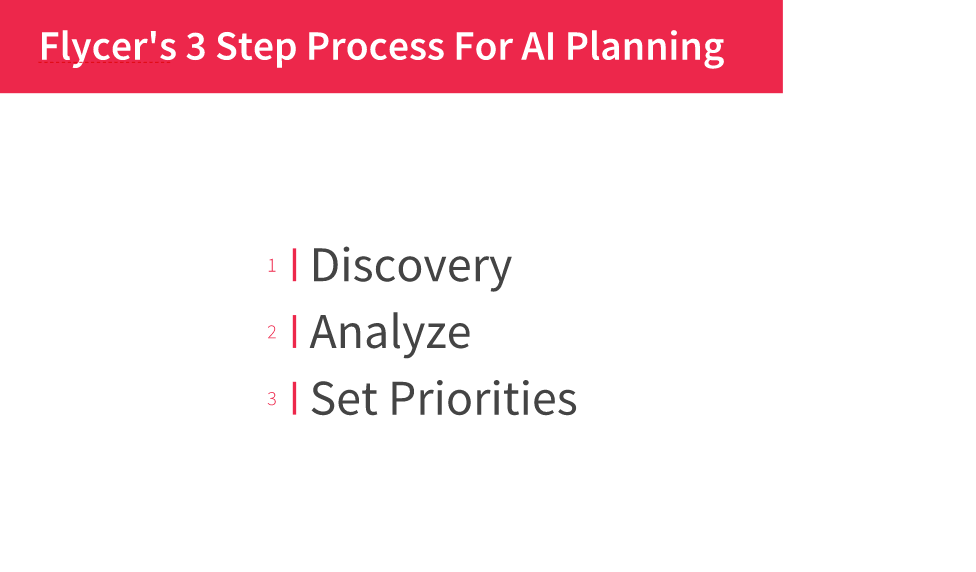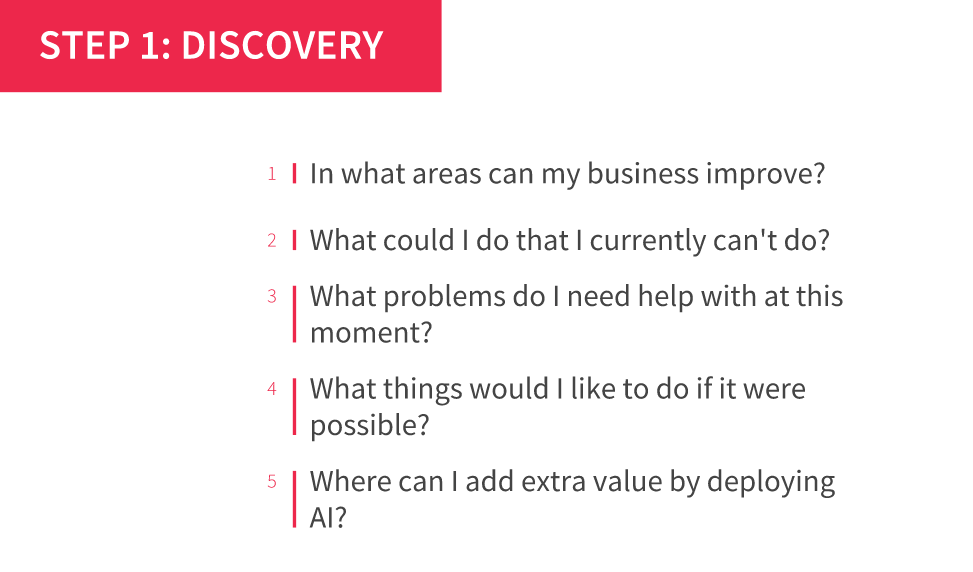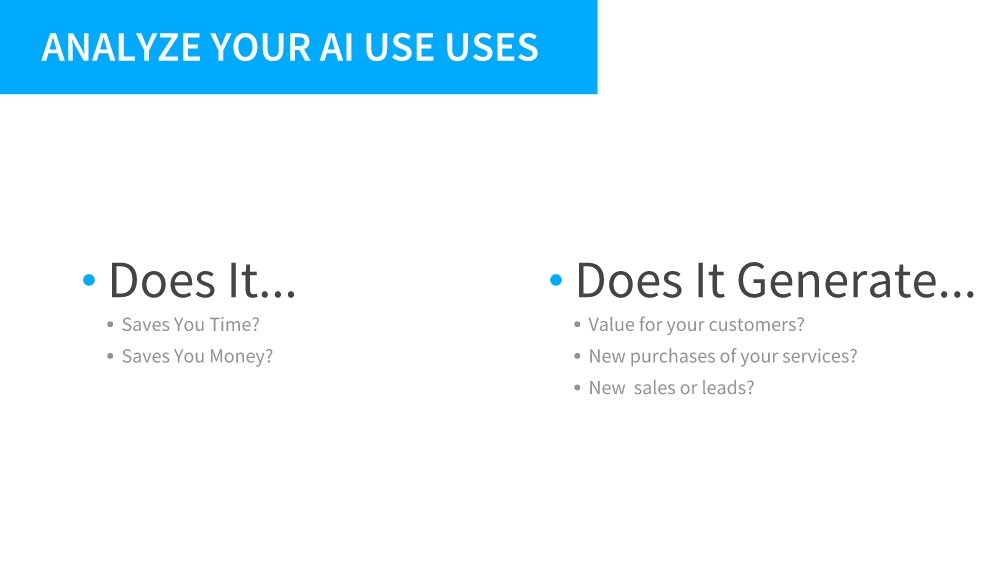How To Create An AI Plan For Small Businesses
step by step tutorial
INTRODUCTION:
Planning to implement AI for small businesses can be confusing. You might don’t even know where to start.
With so many applications of Artificial Intelligence, choosing one successful use to grow, and secure the future of your business can be a challenge.
The moment you start reading online about Artificial Intelligence, you hear of many unfamiliar terms: deep learning, machine learning, neural networks, etc. and it makes your mind spin. Also, many of the reference material online is targeted for enterprises and startups. But not much information is out there for small and medium businesses.
- Why Is Important To Plan (The Stakes)
- What Is An AI Blueprint
- Step #1 – Discovery
- Step #2 – Analyze
- Step #3 – Prioritize
- How To Create Your AI Blueprint
- Applying AI To Marketing
- Resources
How can you do effective AI planning without falling into these pitfalls?
In this blog post, we’ll help you introduce Artificial Intelligence innovations for maximum profits and limited budgets to produce a positive impact. We do this using a single, easy-to-understand blueprint instead of many plans. It will help you avoid wasting your time in tech, tools and hyped trends around artificial intelligence.
And it will help you develop a plan, short-cutting it to days, something available only to great leaders and businesses.
Who is this planning system for:
We made this system for small business owners and/or decision makers of smbs (small businesses) that want to learn how to leverage artificial intelligence to improve the performance of their companies.
Who else can benefit from it:
Medium size companies and startups who want to run smarter AI operations.
Why Is Important To Plan Your Artificial Intelligence Solutions:
It is everywhere in the news, all the major corporations and big businesses around the world are rushing to integrate artificial intelligence in their organizations. Billions of dollars are invested in funding, to hire teams of data scientists and other experts to develop artificial intelligence before their competitors.
But how about small businesses? Successful small business does not have the same resources as the big ones. Fortunately, that is starting to change.
Where is the danger then? Lacking behind in this digital race is extremely dangerous.
Here’s why: Artificial Intelligence is not deployed easily, and the last thing you want to do is compete against companies in your market that are already leveraging it. Or worse yet, keep competing with them without planning to use AI yourself.
So the question is: How long can I afford to go without an artificial intelligence plan? Or stay out of the AI race?
If you don’t think about how you can leverage artificial intelligence, some other businesses in your area will do some planning themselves. In that scenario, they will increase their profits and growth at your expense. And obtain a tactical advantage over you quickly.
in this tutorial, we will explain how you can build your AI blueprint in 3 Steps.
So you can discover, analyze and prioritize your AI Investments according to the impact that will generate in your company.
This planner can be used for scenarios where you and your team wonder: how do I integrate AI into my business?
What Is An AI Blueprint?
An AI blueprint is a portfolio of AI opportunities.
We include here the concepts of both AI and machine learning. We will classify these opportunities in order of importance. So you can clearly identify which one fits best with your strategy and business goals. Both in the short, and long-term.
As a result of your research, your blueprint plan will show you what are the safest, quickest and most profitable ways to go about artificial intelligence in your business.
How To Plan AI Adoption For Small Businesses
Sometimes we can’t see the forest for the trees when it comes to all the things that we can do with AI.
The system is this tutorial is a proven method to build an AI blueprint plan in three stages:
- Discover how you can use AI within your small business.
- Analyze.
- Set priorities.
Even though it’s impossible to see all the opportunities at artificial intelligence opens for you from the get-go, this process will give you insights into what makes sense and what it doesn’t.
And it will help you identify the best way to implement business AI for your small business, making your planning easier.
Let’s focus on the introductory step to build your small business blueprint.
Step #1 – The Discovery Phase (Used For Scenario Planning)
The goal of this phase is to find out use cases from AI.
So we can measure and evaluate them in the next steps of our blueprint plan. Don’t look at it like if it were a business plan.
Discovery is not about the specifics of the technology or its features. At this point, we are not looking to answer the “how-to” questions, but rather, the “What” questions. We are searching for uses AI can provide, advantages against other businesses.
Here’s how to do it:
Write down all the ideas that you and your team can brainstorm. Don’t leave anything behind. At this point, we are simply collecting ideas.
Who is involved: At this point in the process you might want to include the key decision stakeholders in the business to help you identify the several ways to implement AI.
Ask yourself:
- In what areas can my business improve?
- What could I do that I currently can’t do?
- What problems do I need help with at this moment?
- What things would I like to do if it were possible?
- Where can I add extra value by deploying AI?
Who else can you turn to in search of ideas?
You can:
- Consult with other employees.
- Current customers
- Fans of your brand (if you have)
Ask them how would they improve your service.
As a result of this input, plan accordingly. Begin asking the right questions. For example:
- Can we improve our customer service by using AI?
- Or, can AI help us to generate predictions to generate more sales?
At the end of the discovery process, you should have a good amount of ideas and use cases that can impact your business.
Remember: you need to have a good amount of use cases ideas and data to work with.
Take a few days to research before moving on to step 2.
Well done! Now that you and your team have brainstormed some ideas for where you can apply intelligence AI, it’s time to
Step #2 – Analyze Your AI Use Uses
What do you do next?
Analyze the potential of each of your ideas. Score each of the fields on a scale from 1 to 10.
Our recommendation is to always look for things that:
Our recommendation is to always look for things that:
- Saves you time
- Saves you money
Generates:
- Value for your customers
- New purchases of your products or services
- New sales or leads.
A simple method to evaluate the pros and cons of AI implementation in your business, is to create a spreadsheet with three columns:
On the opening column score from 1 to 10 the level of impact that those plans will have in your business in these three vectors:
- Strategic – How will this AI adoption impact my place in the market?
- Financial – What financial resources are necessary to leverage this particular idea?
- Human – Will this optimize our employee’s time? Or will it help us avoid hiring more people in the future? Or save on labor?
Do the same with the next column (picture above). Please score the “Effort Involved” metric.
On this column we evaluate and measure the following features:
- Development – How long will it take to develop the AI solution?
- Integration – How easy will be to integrate it with the workflow of our business?
- Change management – How easy will be for everyone to adapt to it?
On the last column we will score is the risk factor. Score from 1 to 10 how risky each AI use case is.
IMPORTANT NOTE: This column is scored as: 10 – risk level is lowest, 1 is the riskiest.
When you work with artificial intelligence, you want to make sure that you keep a list of all the potential harm and drawbacks artificial intelligence can have in your business. Reference data are abundant online on how to do this.
NOTE: In the context of small and medium sized businesses planning, this column does not carry much weight, unless you have sensitive data from your customers, like in healthcare. Or your work entails risks.
Bigger sized businesses usually need to consider this column comprehensively.
Still, we consider that is column is worth including.
Step #3 – Prioritize And Create Your Use Cases
You are almost finished.
For each column, think about what is the possible downturn:
- Financially
- Physically
- Psychologically
For this groups:
- Employee’s
- Stakeholders
- Customers
The three main areas to evaluate risks are:
- Safety
- Trust
- Accountability
By now, your spreadsheet is filled.
ADD UP ALL THE FIGURES AND SORT THEM BY SCORE
You can now see the impact of integrating each AI use case.
Looking at the filled out table, you can evaluate the effort and risk involved, and compare that total figure to the other uses that you have brainstormed during the discovery phase.
By collecting data in the suggested format, and doing this simple exercise, you will picture clearly which ideas generated in your brainstorming have a better shot at succeeding with AI.
You’ll see clearly what capabilities and uses will work for your organization.
As might realized by now, the are advantages of following this methodology:
- It translates into cost savings.
- It avoids wasted time.
And avoids falling to “the shiny object syndrome”. Ideas that appeared to be very good, but turned out to be too risky, or required a huge effort making it work for your business.
BONUS POINT – YOUR AI BLUEPRINT IS REVEALED.
Once you have identified some viable use cases for your company, prioritize which of the AI projects you want to implement first. It should be as simple as looking at the highest scoring results. What did the chart say about what are the most important use cases to implement?
By following those results in order of importance, you transformed your plan into a blueprint for your small business.
Our suggested plan will be:
- Choose the highest score use case. Define how to kick-start it.
- Use it for small uses and continue building on and scaling up those use cases.
- Define short-term goals and long-term goals.
- Do not forget to assign a budget to each of the goals.
- Define a common vision for artificial intelligence in your business and share it with the key decision-makers. That way, everyone in the team will all be aligned with that vision.
As a last note, there are certain AI capabilities that you can plan to be reused in other future goals in your business. This increases your ROI. Make sure to cluster together or use an AI capability for different projects.
HAVE YOU CONSIDERED …
If you’re a small business owner and are planning an intelligent AI strategy for marketing, consider well your financial budget. If you don’t have the resources, management, leaders nor the experience to put together an AI team, we can help.
Flycer AI has developed and trained a system, powered by AI, for marketing for small businesses. There’s no need for planning or investing in machine learning on your own. At Flycer AI, we say that it is kind of having the world’s best marketer, for a fraction of the cost. And on top of that, it works 24/7 for your business.
When we founded Flycer AI, we knew that small businesses couldn’t compete with the technology, resources of bigger corporations. That’s why we created an AI powered solution that small companies can leverage to profit and grow. By becoming partners with many small businesses, we dramatically lower the investment needed to access artificial intelligence. If you want to see the application of AI technology for digital marketing, we have the tech, tools, and experience for your success.
Ask us if you can use AI powered marketing to grow your business too.
if you would like to see AI and machine learning working for your company, contact us for a free demo and see the potential for your business. Learn more here.
take the quiz
AI Readiness Quiz
60 Seconds Away To Learn If You Are Ready














